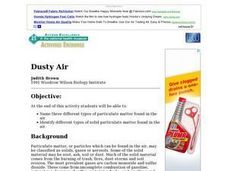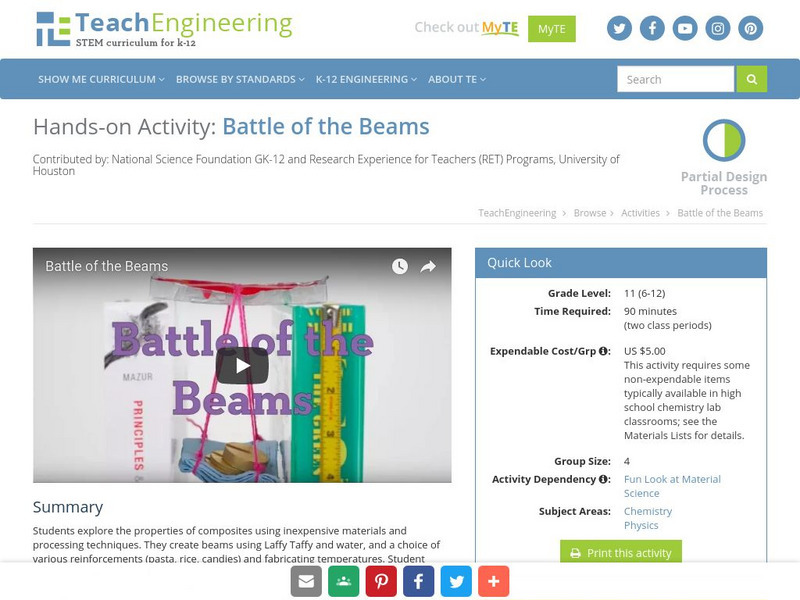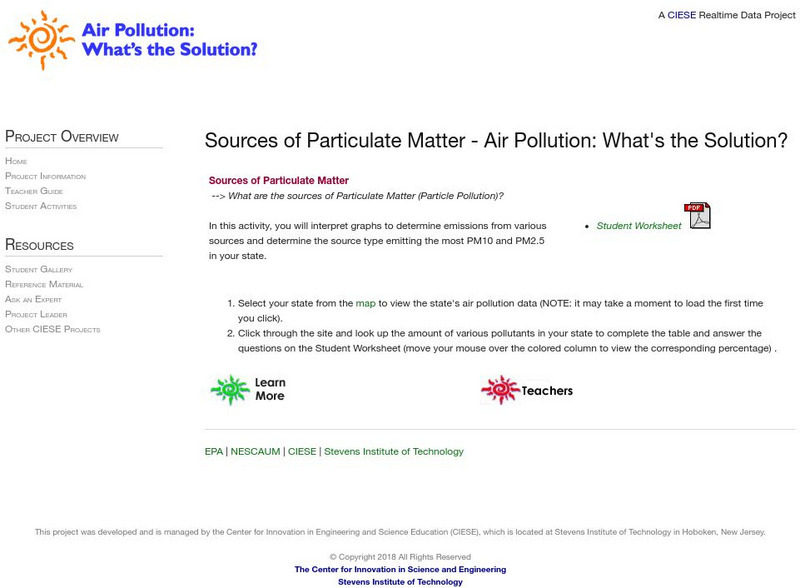Curated OER
When A Car Coughs. . .
Budding scientists collect and compare particulate exhaust from four different vehicles. They discuss how cars contribute to air quality. To get the most mileage out of this resource, have learners complete the optional step 5, in which...
Curated OER
Particulate Observation Lab
Students collect samples of common dust from their homes and school for examination under a microscope. They identify the components of their samples using the provided "Atlas of Indoor Dust Particles." Pupils take samples form a variety...
Curated OER
Dusty Air
Young scholars discover the types and amounts of particulate matter found in the air. They collect particulates using a Petri dish coated with Vaseline then classify and count the collection under a stereoscope.
Curated OER
Create Your Own Investigation
Middle schoolers design and implement an experiment intended to measure and analyze the air quality of a particular location. They focus on looking for ozone and particulate pollutants.
Yale University
Yale New Haven Teachers Institute: Atmospheric Changes
Lesson unit on the effects of fossil fuel burning on the atmosphere. Includes particulates with good materials balance.
Georgia Department of Education
Ga Virtual Learning: Ap Environmental Science: Air Pollution and Climate Change
Through this interactive module, students learn that the atmosphere is so much more than air, its complex role on Earth should be explored, and its quality carefully monitored and protected.
TeachEngineering
Teach Engineering: For Your Eyes Only
Students develop their understanding of visible air pollutants with an incomplete combustion demonstration, a "smog in a jar" demonstration, and by building simple particulate matter collectors.
NASA
Nasa Earth Observatory: Natural Hazards: Dust, Smoke, and Haze
NASA's Earth Observatory offers photographs of dust, smoke, and haze throughout the world. Learn how these pollutants can be hazardous to our Earth.
US Environmental Protection Agency
Epa: Criteria Air Pollutants
Find out about the six major air pollutants. In-depth descriptions of ozone, nitrogen dioxide, particulates, sulfur dioxide, carbon monoxide, and lead are provided.
TeachEngineering
Teach Engineering: Battle of the Beams
Students explore the properties of composites using inexpensive materials and processing techniques. They create beams using Laffy Taffy and water, and a choice of various reinforcements (pasta, rice, candies) and fabricating...
Center for Innovation in Engineering and Science Education, Stevens Institute of Technology
Ciese Real Time Data Projects: Size, Shape and Health Effects of Particulates
How does particulate pollution affect people with breathing disorders? Real time air quality data is provided for you to assess your state. Using this data you can determine who might be at risk in your particular area.
Center for Innovation in Engineering and Science Education, Stevens Institute of Technology
Ciese Real Time Data Projects: Air Pollution: Sources of Particulate Matter
Find out what sources are contributing to the particulate pollution in your state. An interactive bar graph shows the major types of air pollution and their sources. This particular activity focuses on two types of particulates.
NASA
Nasa Earth Observatory: Global Maps: Aerosol Optical Depth
View Earth's aerosol optical depth by watching a global map evolve from January 2005 to November 2008. Learn about aerosol amounts such as volcanic ash, sea salt, smoke, and other pollutants.
University of Washington
Live From Earth & Mars [Nasa]: Danger in the Air
This site from Live from Earth & Mars [NASA] is a lesson plan using both interactive and written materials. Can be used as a unit or individually.
Other
Air Pollution and Health Effects
This site lists the health effects from being exposed to air pollution. It also includes the source from where each type of air pollution comes from.
Other
Clean Air Revival: Burning Issues: Constituents of Wood Smoke
Site has several articles on particles from wood smoke and its health effects.
Other
California Air Resources Board: Air Pollution Particulate Matter Brochure
This online brochure focuses on particulate matter in the atmosphere and its health effects.
TeachEngineering
Teach Engineering: Dangerous Air
By tracing the movement of radiation released during an accident at the Chernobyl nuclear power plant, students see how air pollution, like particulate matter, can become a global issue.
TeachEngineering
Teach Engineering: I Breathe What??
In this activity, students will capture and examine the particles to gain an appreciation of how much dust, pollen and other particulate matter is present in the air around them. Students will place "pollution detectors" at various...
CK-12 Foundation
Ck 12: Earth Science: Effects of Air Pollution on the Environment
[Free Registration/Login may be required to access all resource tools.] How pollution damages the environment.
National Institutes of Health
Niehs: Kids' Pages: What Is in Dust?
Do you know what is in dust? Play this matching game to see if you know where things found in dust come from. Answers are provided.
CK-12 Foundation
Ck 12: Earth Science: Composition of the Atmosphere
[Free Registration/Login may be required to access all resource tools.] Describes the gases that the atmosphere is made out of.
NASA
Nasa Earth Observatory: What Are Aerosols? Fact Sheet
This article discusses tiny particles in the air called aerosols. There are naturally occurring aerosols from volcanic ash, sea spray, grassland fires, and other sources. Learn how scientists believe that aerosols have effects on the...
PBS
Nova Teachers: Can Buildings Make You Sick: Classroom Activity
In this lesson plan, participants will build a structure to collect particulates from the air from around the school building. Then observe and analyze the samples obtained to study indoor and outside air pollution.















![Live From Earth & Mars [Nasa]: Danger in the Air Unit Plan Live From Earth & Mars [Nasa]: Danger in the Air Unit Plan](https://content.lessonplanet.com/knovation/original/31323-26b66437de70b854e5f27493404e18f2.jpg?1661447569)









